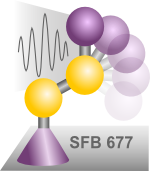Subproject Overview
![]()
Project Area A
First and foremost, we will synthesize the elementary molecular switches as well as their neighboring environment (supramolecular aggregates) in homogeneous solution using classical methods of synthetic chemistry. Elemental processes, e.g. the switching process and its mechanism, will also be investigated in solution first, as there are efficient analytical methods available for this environment. We will benefit from these results to establish and optimize the application of the molecules on surfaces (project area B) and in functional materials (project area C).
show list of projects in area A
Project Area B
Arranging and operating switching molecules on surfaces comprises the subprojects in area B. The alignment of the switches on the surface, i.e. distance and orientation of the switches with respect to the surface as well as to each other, is an essential requirement to achieve a programed function. Scanning tunneling microscopy and spectroscopy are availabe to characterize surfaces. Various efficient surface sensitive techniques will be used to to confirm the switching process and the triggered function.
show list of projects in area B
Project Area C
The incorporation of molecular switches into functional materials such as coordination polymers, pores or nanocomposites facilitates the switching of properties such as conductivity, refraction, diffusion or adsorption. Target applications include switchable storage media as well as optical and molecular filters.
show list of projects in area C
Project Area Z
Project area Z contains the collaborative research center's central projects, i.e. the research training group as well as public relations.
show list of projects in area Z









